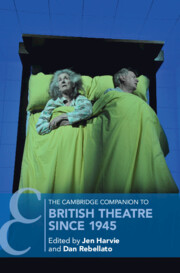Book contents
- The Cambridge Companion to British Theatre since 1945
- Cambridge Companions to Theatre and Performance
- The Cambridge Companion to British Theatre since 1945
- Copyright page
- Contents
- Illustrations
- Contributors
- Acknowledgements
- Chronology of British Theatre since 1945
- Introduction
- Part I Theatre Makers
- Part II Theatre Sectors
- Chapter 4 West End and Commercial Theatre
- Chapter 5 Subsidised Theatre
- Chapter 6 The Fringe
- Part III Theatre Communities
- Part IV Theatre and State
- Further Reading
- Index
- Other Volumes in the Series of Cambridge Companions (continued from p.ii)
Chapter 4 - West End and Commercial Theatre
Crisis, Change, and Continuity
from Part II - Theatre Sectors
Published online by Cambridge University Press: 14 March 2024
- The Cambridge Companion to British Theatre since 1945
- Cambridge Companions to Theatre and Performance
- The Cambridge Companion to British Theatre since 1945
- Copyright page
- Contents
- Illustrations
- Contributors
- Acknowledgements
- Chronology of British Theatre since 1945
- Introduction
- Part I Theatre Makers
- Part II Theatre Sectors
- Chapter 4 West End and Commercial Theatre
- Chapter 5 Subsidised Theatre
- Chapter 6 The Fringe
- Part III Theatre Communities
- Part IV Theatre and State
- Further Reading
- Index
- Other Volumes in the Series of Cambridge Companions (continued from p.ii)
Summary
This chapter focuses on the Apollo Theatre, Shaftesbury Avenue, and discusses the post-war history of West End and commercial theatre in Britain. It aims to consider the ways the commercial sector and its proprietors, producers, and productions, have been shaped by, and have responded to, the changing conditions of the industry in this period. Starting and mostly staying in one location – resolutely in the heart of London’s ‘Theatreland’ – creates a tight spatial focus in an industry which in many other ways is characterised by movement: of productions, artists, audiences, and influence. The chapter explores a long-running set of tensions between heritage and contemporaneity, culture and development, and artistic and commercial interests that have played out at both the Apollo and across the wider West End and commercial sector. It argues that the Apollo makes for a reasonably representative study of the wider history and trends in post-war commercial theatre. What emerges from its history is a picture of a sector that, despite extraordinary change in both the industry and the world in which it operates, has weathered or absorbed many of these changes and demonstrated continuity, sometimes surprising, sometimes troubling, sometimes remarkable.
Keywords
- Type
- Chapter
- Information
- The Cambridge Companion to British Theatre since 1945 , pp. 83 - 101Publisher: Cambridge University PressPrint publication year: 2024



